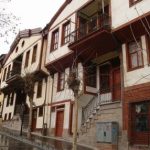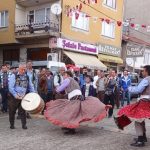Population: 120,000
Old names: Bithynium, Claudiopolis, Hadriana ad Honorias
Market day: Monday
Koroğlu Festival: Late September
Bolu is the small and not especially exciting capital of a conservative province midway along the road between İstanbul and Ankara. It was the birthplace in 110 of Antinous, the handsome lover of the Emperor Hadrian. As a result the city was once endowed with many fine public buildings of which, sadly, there are now few reminders. Much of the town centre is pedestrianised with a cycle lane running down the middle of the promenade.
Although it has a small museum, a lively Monday market, several elderly mosques, and an old han Bolu doesn’t have a great deal to offer visitors. It does, however, make a good base for local excursions, especially to Turkey’s “Little Lake District”.
The story of Köroğlu A statue of Köroğlu (Son of a Blind Man) stands in front of the Hotel Köroğlu in the town centre. The hero of medieval epic stories first written down in the 18th century, Köroğlu comes across as rather like an Anatolian version of Robin Hood.
In the most common story Köroğlu is Rusen Ali, the son of a stablehand who worked for the governor of Bolu. His father had recommended a weak horse to the governor as a possible gift for the sultan, confident that it would turn into a fine animal if better treated. Furious, the governor had him blinded whereupon Rusen Ali became hell bent on avenging his father. Hızır then appeared to the father in a dream and suggested that if he drank foam from the river Aras he would recover his eyesight and become immortal. However, only one person could benefit from this miracle. In some versions of the story it is Rusen Ali, in others the horse. In none is it the father.
Around town
 The most obvious place to start exploring Bolu is the museum (closed Mondays) on the hill behind the Hotel Köroğlu near the vast Cadde shopping mall. The ground floor has a fairly mundane collection of archaeological finds from Bolu itself, as well as from nearby Seben. The finest single piece is a marble head of a Roman woman, so detailed that it resembles a waxwork. Near the door there is also an impressive late Roman memorial to a local gladiator.
The most obvious place to start exploring Bolu is the museum (closed Mondays) on the hill behind the Hotel Köroğlu near the vast Cadde shopping mall. The ground floor has a fairly mundane collection of archaeological finds from Bolu itself, as well as from nearby Seben. The finest single piece is a marble head of a Roman woman, so detailed that it resembles a waxwork. Near the door there is also an impressive late Roman memorial to a local gladiator.
Upstairs the ethnographic section contains an interesting collection of oya, the embroidery with which rural women decorate their headscarves. There are also models of a woman and her mother-in-law at a kına gecesi (henna night) before a wedding.
As so often, the finest items in the museum are actually in the grounds outside. Unusually well labelled, they make it plain how built-up an area this must have been in Roman times. For example, the columns and pediment from a huge 2nd-century temple of Trajan suggest that what is now the village of Kargatepesi was once much more important. A cluster of graves found during recent roadworks are displayed in situ. Near the gate are five huge Roman sarcophagi discovered in the town centre as recently as 2007.
A major landmark in town is the Yıldırım Beyazıt Cami, also known as the Büyük Cami (Great Mosque). The first mosque on the site dated back to the end of the 14th century (the Orta Hamamı survives from the complex) but burnt down in 1803. The current model dates from 1901.
Facing it across the road is the Yukarı Taşhan (Upper Stone Han), an unexpectedly attractive han whose courtyard is surrounded by a double arcade of small shops, most of them still in use. The same fire that consumed the mosque also claimed the original han. The complex, including its small birdhouses, was completely restored in 2004 although the huge metal gates are original.
 On the far side of the main square from the Büyük Cami stands the brick-built Saraçhane Cami (1750), which replaces a lost Sinan mosque. Nearby are the Orta Hamamı and the austere Kadi Cami (1499). In the main square itself there is a small statue of local industrialist İzzet Baysal (1907-50). Further along the road another old hamam has been turned into a posh shoe shop.
On the far side of the main square from the Büyük Cami stands the brick-built Saraçhane Cami (1750), which replaces a lost Sinan mosque. Nearby are the Orta Hamamı and the austere Kadi Cami (1499). In the main square itself there is a small statue of local industrialist İzzet Baysal (1907-50). Further along the road another old hamam has been turned into a posh shoe shop.
South and east of the Büyük Cami there are still many old Ottoman houses in a parlous state of repair as well as a few that have been restored. A fine piece of Roman masonry is embedded in the minaret of the Semerkant Cami. Finally, you may come across some lines of marble seating from a Roman stadium embedded in the bottom of a hill. 
Sleeping
Bolu has one of the least inspiring collections of city-centre hotels in Turkey. Most are old-fashioned, poorly equipped and over-priced in what is, sadly, a cynical seller’s market.
Bolu Termal Otel. Tel: 0374-262 8472
 Women selling mushrooms in front of Kadı Cami in late September. The one on the left is wearing typical local striped şalvar.Transport info
Women selling mushrooms in front of Kadı Cami in late September. The one on the left is wearing typical local striped şalvar.Transport info
Regular buses to Bolu from İstanbul and Ankara terminate at a remote bus station connected to the town centre by servis buses but very few normal city buses.
Timetabled buses to Mudurnu leave from a ticket office in the town centre near the Valilik. Less frequent but also timetabled minibuses to Seben leave from an entirely separate ticket office to the south of town opposite the BP petrol station.
Don’t try and visit the ruins of Hadrianopolis by bus from Bolu since you will be dropped on the main road at Mermer with another 3-4km to walk uphill. There’s only one taxi waiting to take you there and the driver will charge through the nose for the privilege. Visit from Karabuk instead.
Frequent buses to the thermal hotels at Kaplıca leave from behind the Saraçhane Cami.
Day trip destinations
Gölcuk
Kartalkaya



